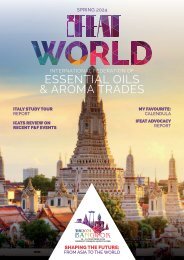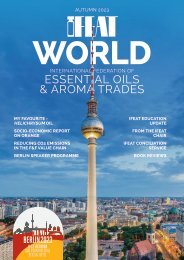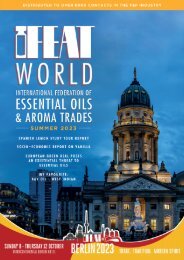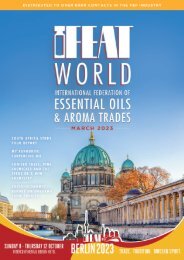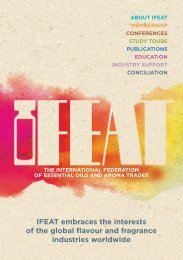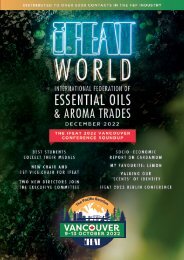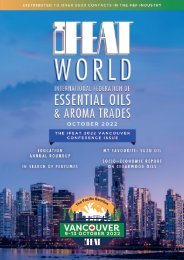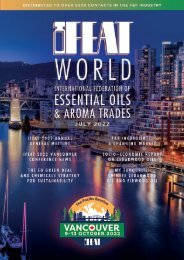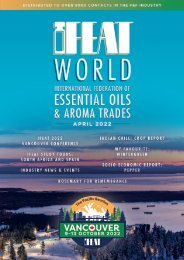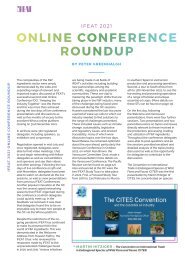IFEATWORLD September 2021
IFEATWORLD is an aroma trades publication for members of IFEAT - The International Federation of Essential Oils & Aroma Trades
IFEATWORLD is an aroma trades publication for members of IFEAT - The International Federation of Essential Oils & Aroma Trades
- No tags were found...
You also want an ePaper? Increase the reach of your titles
YUMPU automatically turns print PDFs into web optimized ePapers that Google loves.
WORLD 33<br />
African lime oils on behalf of the Rose<br />
Company which was later to become<br />
part of Schweppes in the 1950s and<br />
then Coca Cola.<br />
One of my earliest memories of the<br />
industry is seeing flasks of Cuban<br />
lime oil packed in straw lined wooden<br />
cases. The unlabelled flasks had to be<br />
sampled carefully as there was always<br />
one or two of the more valuable dark<br />
green cold-pressed oils in a shipment.<br />
Disappointingly, during a four-day trip<br />
to Cuba in the 1990s, I was unable<br />
to visit the one very dilapidated lime<br />
factory near Guantanamo Bay.<br />
One of my first tasks during my training<br />
in the 1970s was uncorking small<br />
aluminium bottle samples from UNPAL<br />
(the National Union of Lime Producers<br />
of Mexico) and checking the optical<br />
rotation which was the main analytical<br />
parameter for quality. I can still<br />
recollect the volatile fresh top notes.<br />
Mexico had been processing Key<br />
limes since the 1930s. By the 1970s<br />
more than 500 tonnes a year of oil<br />
were exported. Mexico also grows<br />
Persian limes which have an inferior<br />
flavour. Persian limes are only<br />
processed to produce cold pressed<br />
oil, not distilled oil. Persian distilled<br />
lime oil was produced in Florida<br />
during the 1980s by Howard Kendal<br />
but did not gain market acceptance<br />
as it was perceived as too different<br />
from distilled Key lime oil.<br />
Key limes had been grown in Peru<br />
for many years for use in ceviche (a<br />
fish dish marinated in lime juice).<br />
Frequently there could be an<br />
extreme oversupply of limes during<br />
El Niño years as the quantity of fish<br />
caught in the Pacific Ocean could<br />
be substantially reduced thereby<br />
reducing fresh lime consumption. A<br />
Mexican missionary named Porfirio<br />
Díaz was based in northern Peru and<br />
he introduced the technology for<br />
lime processing in 1967. The lime oil<br />
price then began its decline from<br />
$14.75 to $4.50 per pound in weight,<br />
as there was overproduction. In 1982<br />
I made my first visit to Peru which<br />
was swiftly followed by a visit to<br />
Mexico, hosted by my good friends<br />
the Readhimer family who this year<br />
are celebrating 50 years of lime<br />
processing.<br />
MY FAVOURITE • DISTILLED KEY LIME OIL




